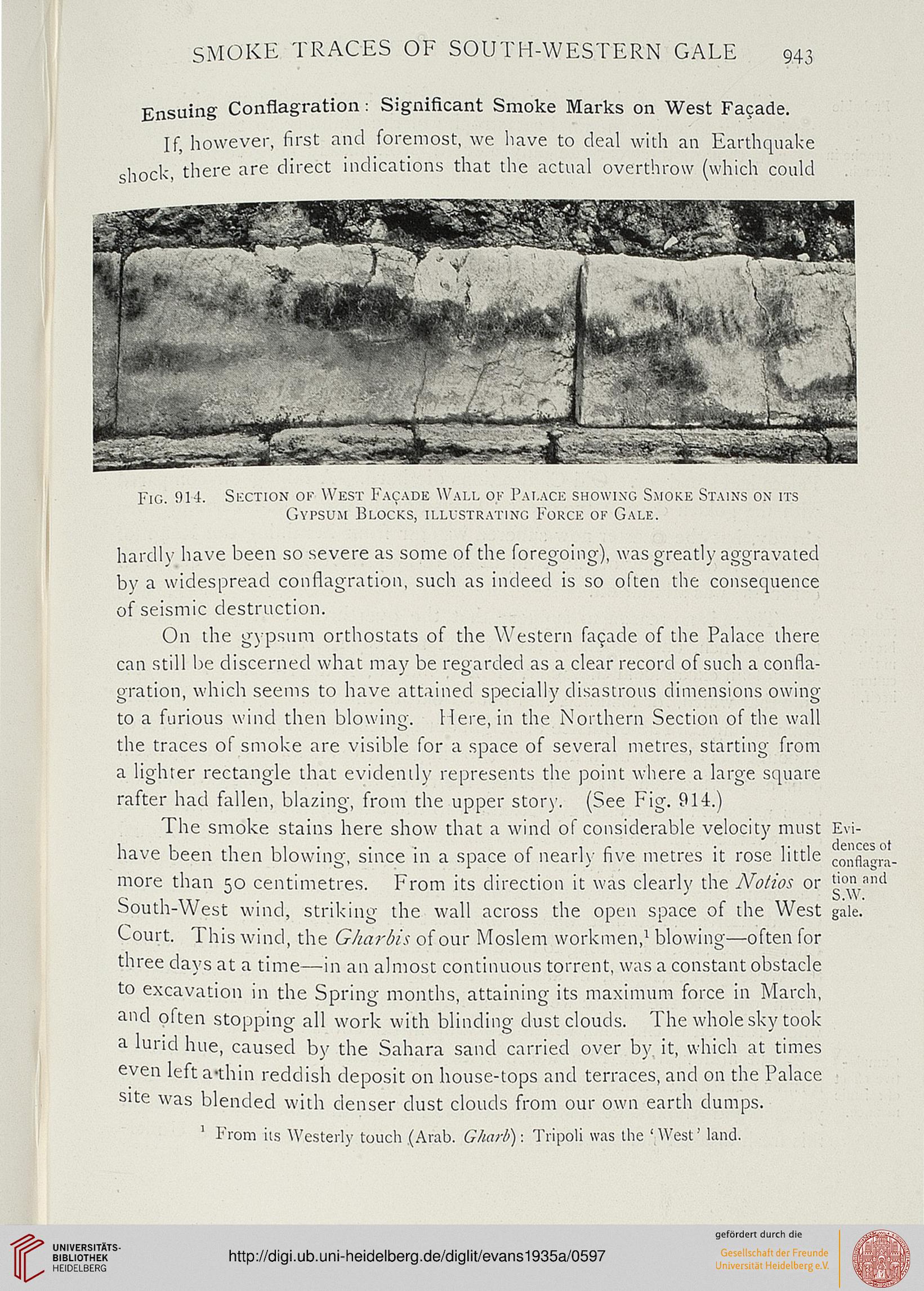SMOKE TRACES OF SOUTH-WESTERN GALE 943
Ensuing Conflagration: Significant Smoke Marks on West Facade.
If, however, first and foremost, we have to deal with an Earthquake
shock, there are direct indications that the actual overthrow (which could
S*!5ife£S^3S£
Fig. 914.
Section of West Facade Wall of Palace showing Smoke Stains on its
Gypsum Blocks, illustrating Force of Gale.
hardly have been so severe as some of the foregoing), was greatly aggravated
by a widespread conflagration, such as indeed is so often the consequence
of seismic destruction.
On the gypsum orthostats of the Western facade of the Palace there
can still be discerned what may be regarded as a clear record of such a confla-
gration, which seems to have attained specially disastrous dimensions owing
to a furious wind then blowing. Here, in the Northern Section of the wall
the traces of smoke are visible for a space of several metres, starting from
a lighter rectangle that evidently represents the point where a large square
rafter had fallen, blazing, from the upper story. (See Fig. 914.)
The smoke stains here show that a wind of considerable velocity must
have been then blowing, since in a space of nearly five metres it rose little
more than 50 centimetres. From its direction it was clearly the Nolios or
South-West wind, striking the wall across the open space of the West
Court. This wind, the Gharbis of our Moslem workmen,1 blowing—often for
three clays at a time—in an almost continuous torrent, was a constant obstacle
to excavation in the Spring months, attaining its maximum force in March,
and often stopping all work with blinding dust clouds. The whole sky took
a lurid hue, caused by the Sahara sand carried over by it, which at times
even leftanhin reddish deposit on house-tops and terraces, and on the Palace
site was blended with denser dust clouds from our own earth dumps.
' From iis Westerly touch .(Arab. Gharb): Tripoli was the 'West' land.
Evi-
dences of
conflagra-
tion and
S.W.
gale.
Ensuing Conflagration: Significant Smoke Marks on West Facade.
If, however, first and foremost, we have to deal with an Earthquake
shock, there are direct indications that the actual overthrow (which could
S*!5ife£S^3S£
Fig. 914.
Section of West Facade Wall of Palace showing Smoke Stains on its
Gypsum Blocks, illustrating Force of Gale.
hardly have been so severe as some of the foregoing), was greatly aggravated
by a widespread conflagration, such as indeed is so often the consequence
of seismic destruction.
On the gypsum orthostats of the Western facade of the Palace there
can still be discerned what may be regarded as a clear record of such a confla-
gration, which seems to have attained specially disastrous dimensions owing
to a furious wind then blowing. Here, in the Northern Section of the wall
the traces of smoke are visible for a space of several metres, starting from
a lighter rectangle that evidently represents the point where a large square
rafter had fallen, blazing, from the upper story. (See Fig. 914.)
The smoke stains here show that a wind of considerable velocity must
have been then blowing, since in a space of nearly five metres it rose little
more than 50 centimetres. From its direction it was clearly the Nolios or
South-West wind, striking the wall across the open space of the West
Court. This wind, the Gharbis of our Moslem workmen,1 blowing—often for
three clays at a time—in an almost continuous torrent, was a constant obstacle
to excavation in the Spring months, attaining its maximum force in March,
and often stopping all work with blinding dust clouds. The whole sky took
a lurid hue, caused by the Sahara sand carried over by it, which at times
even leftanhin reddish deposit on house-tops and terraces, and on the Palace
site was blended with denser dust clouds from our own earth dumps.
' From iis Westerly touch .(Arab. Gharb): Tripoli was the 'West' land.
Evi-
dences of
conflagra-
tion and
S.W.
gale.




